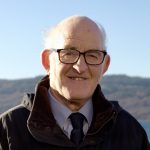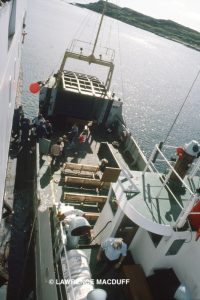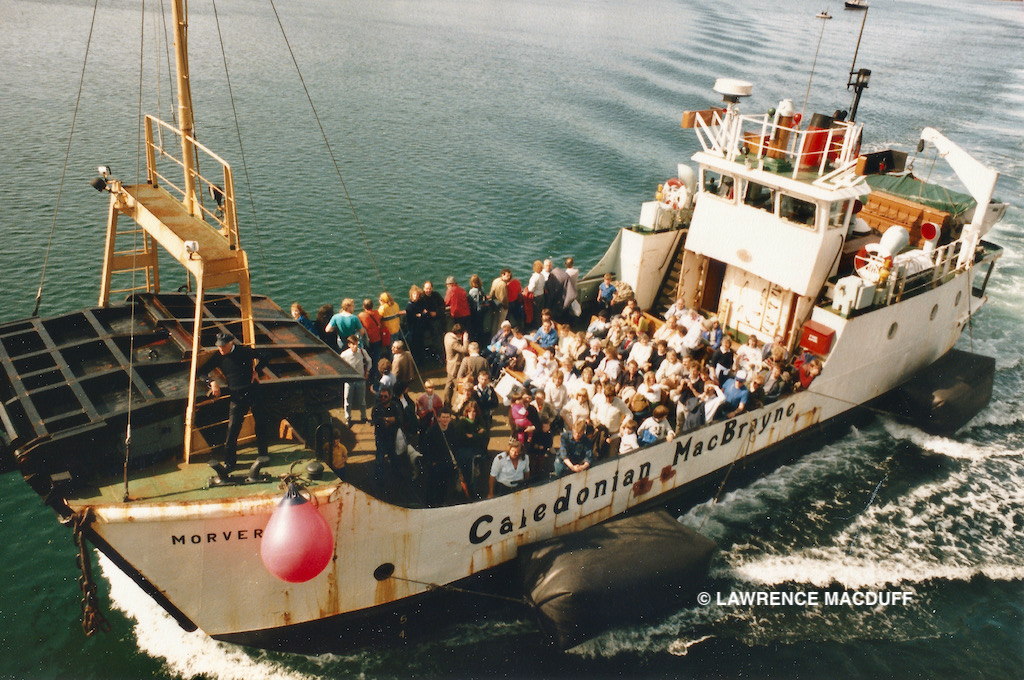
Columba (centre) at anchor in the Sound of Iona on 5 August 1986 — two years before she was sold out of the CalMac fleet. You can just make out her ferry door (between ‘M’ and ‘c’), from which Morvern (right) has taken on a load of passengers for the transfer to shore
In the latest of his ‘Confessions of a Cameraman’, Lawrence Macduff recalls how a visit to Iona in the 1980s was tarnished by a clattering accident.
There can be few Western Isles ship enthusiasts of my generation who did not have the good fortune to enjoy cruises to Iona on the legendary King George V. Indeed it’s hard to believe that nearly half a century has elapsed since the old ship made her final voyage to the Sacred Isle, and that more than 30 years have now passed since her successor Columba did likewise.
However, my latest tale of near-disaster is not about either ship, though without their having conveyed me to Iona, this story might never have been written. The aged flotilla of KGV’s attendant red boats is remembered almost as well as the ship herself, and they survived to serve Columba for a time. At the end of their tenure in the Sound of Iona, their wooden hulls were leaking like a colander. To replace them in the summer of 1979, in came one of that most versatile of CalMac’s small ferries, the ‘Island’ class vessel Morvern.
It was the late great Jim Aikman Smith who rather derisively dubbed the eight ‘Island’ class vessels the ‘daft ducks’. Maybe they weren’t so daft after all: all eight were so robustly built that, 45 years later, they are still on the go — in much modernised and improved condition, in Irish waters.
To suit Morvern for her seasonal duties at Iona, she was granted a Class 6 certificate, permitting the carriage of 164 passengers. Sadly, such ship to shore transits are absent for today’s enthusiast – I mean, what more unusual and exciting process could there be than the business of being swiftly transhipped by a pair of burly seamen over the belting of Columba into an open boat, back in what can only be described as ‘ye good olde days’.
Exciting might be one way of describing it, but for those not used to the experience, the sight of an open boat beset by spray while rising and falling alongside the ship’s belting was probably quite scary.
While the mass transfer of tourists was unique to Iona at that time, ship to shore movement of passengers and cargo was still quite common in remoter islands.
On 9 August 1988 I joined Columba at Oban for an especially memorable cruise to Iona. As a car ferry she looked to be a poor substitute for King George V, but her comfortable warm amenities quickly endeared her to enthusiasts like me. The process of transferring into a small boat to go ashore at Iona was always a super experience and, as was invariably the case, Morvern’s car deck looked more like a massive rugby scrum as the last handful of disbelieving passengers were manhandled onto her deck. She was later joined by her sister Canna, and between the two of them they shifted the loads much more quickly and slickly than had ever been possible with the red boats.
Well, passengers who go ashore on an island invariably must return. Having taken pictures of Columba and the pair of ‘Island’ class ferries hard at work, I made sure — when it was time to be ferried back — that I was amongst those who would be first in line.
Where better to take up position on Morvern than the small bridge deck, from which I knew I would get the best pictures. I happily watched from aloft as the wee ferry was finally loaded to the gunwales before her ramp was raised. Luckily, not so many folk were tempted to climb the almost vertical access ladder to the bridge deck, so I was able to move about more freely, and what a fantastic if rather cluttered viewpoint it was.
There is nothing quite as lovely as the Sound of Iona on a fine clear day: its Caribbean colours, the stunning topography and the beautiful profile of Iona Abbey are in a class of their own. In the few minutes that it took to reach the ship, there was the intriguing waterline view of the solid wall of steel that Columba presented as we neared.
Morvern was deftly made secure alongside, using massive rubber fenders to keep her hull at a safe distance from the larger ferry. As passengers began to be transferred, I moved round to the top of the port side ladder, hooked the straps of my holdall through one arm so that both hands were free and…..before I realised what was happening, I had hurtled downwards without even touching the ladder to land with a jarring crash on the car deck. By some miracle, my outstretched arms and heavy camera holdall did not strike anyone. No one saw or heard me coming – their attention was glued to their fellow citizens being helped upwards out of the boat and in through Columba’s ferry door.

‘From bridge deck to car deck has to be at least 15 feet’: the steep ladder down which Lawrence fell lies at the side of the wheelhouse, opposite the ventilator on the bottom left of the picture
To this day, my partner marvels at how I can waltz effortlessly in and out of my driveway, driving a 40-foot-long school coach without hitting the wall, yet am still able to collide with or trip over every other conceivable object!
Take a look at any picture of an ‘Island’ class ferry and gauge for yourselves just how far it is from bridge deck to car deck – it has to be at least 15 feet. If I had struck anyone with that bag of cameras, or any part of myself, I could have badly hurt some unsuspecting person. My knees all but gave way under me – the thud alerted nearby passengers but no one realised what had happened. I managed to get back on board Columba without further incident, but my knees and back ached for days afterwards and I was lucky not to have had to extend my stay on Mull – at the cottage hospital!
Later in the careers of the ‘Island’ class ferries, access to the bridge deck was barred to passengers, implying that there had been a safety re-appraisal, possibly prompted by similar accidents.
They say that photographs of any occasion convey memories – hopefully pleasant ones. Mine from that day certainly make me wince, but also remind me of many lovely visits to Iona, one of the jewels in the Hebridean crown.
All images on the CRSC website are protected by copyright law. Do not reproduce them on Facebook, Pinterest or any other public platform.
Published on 9 April 2021

















